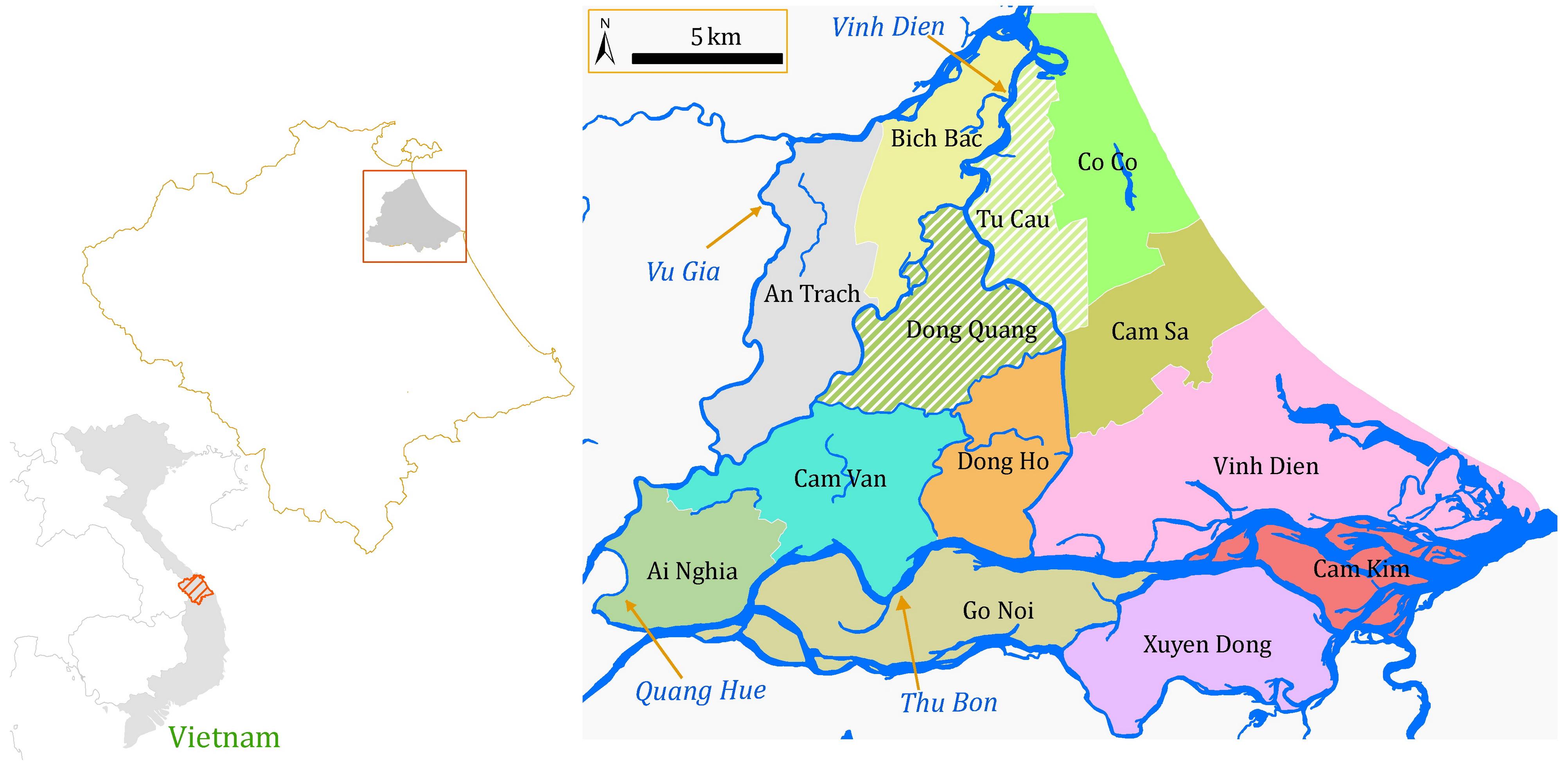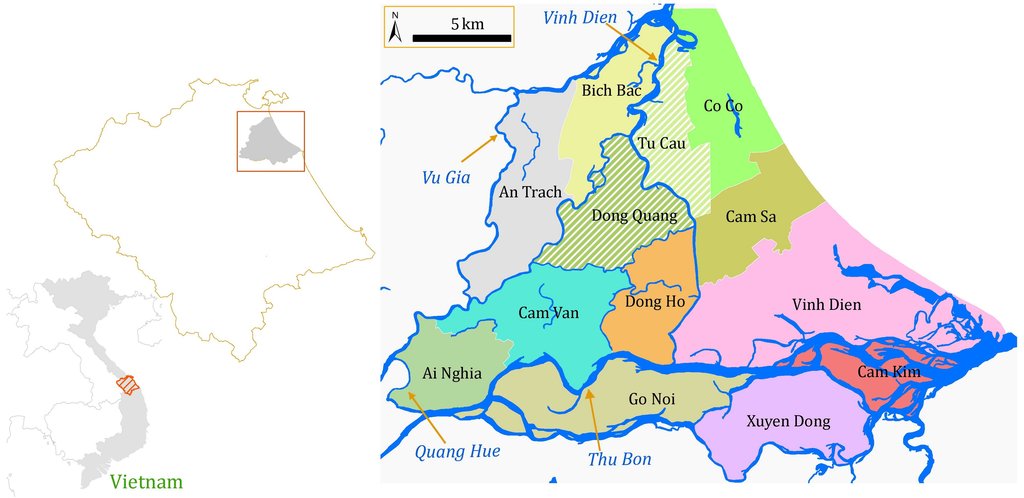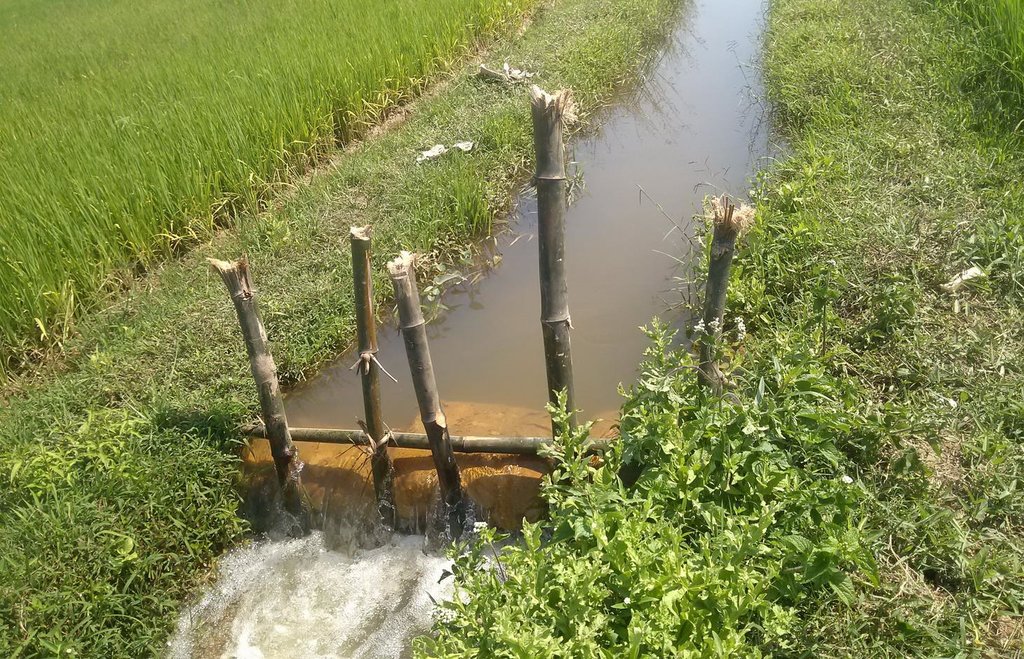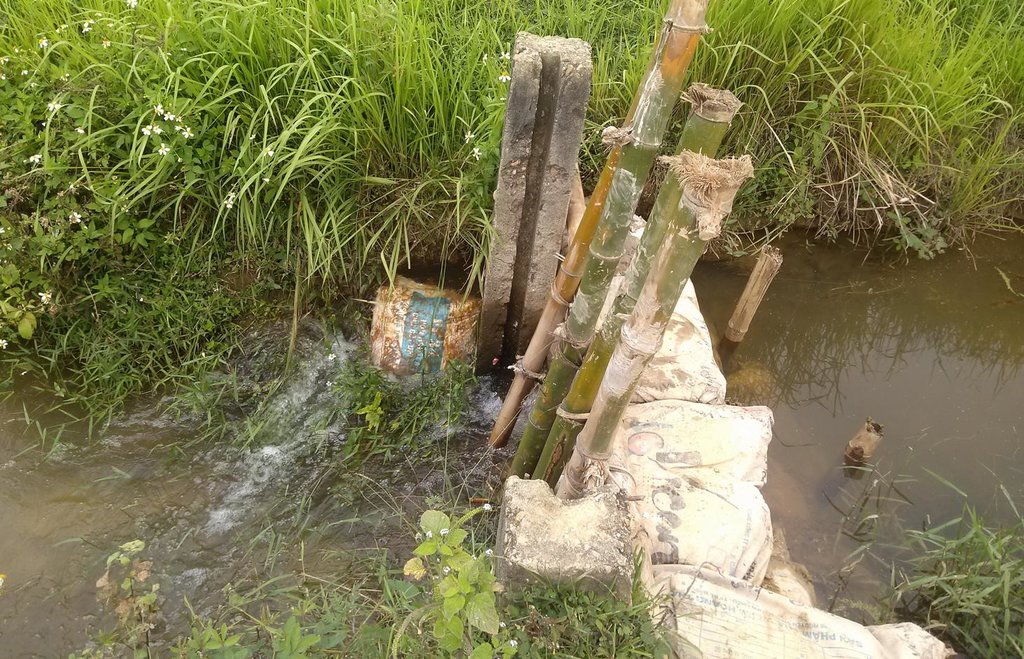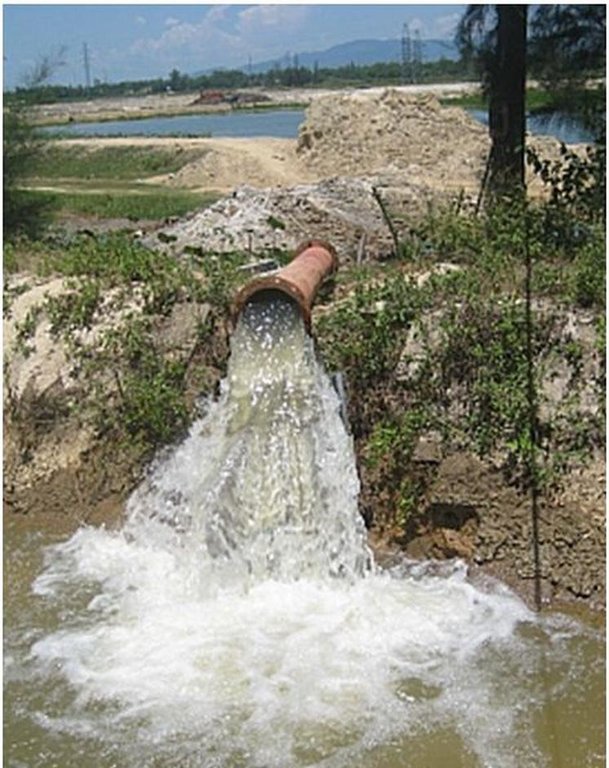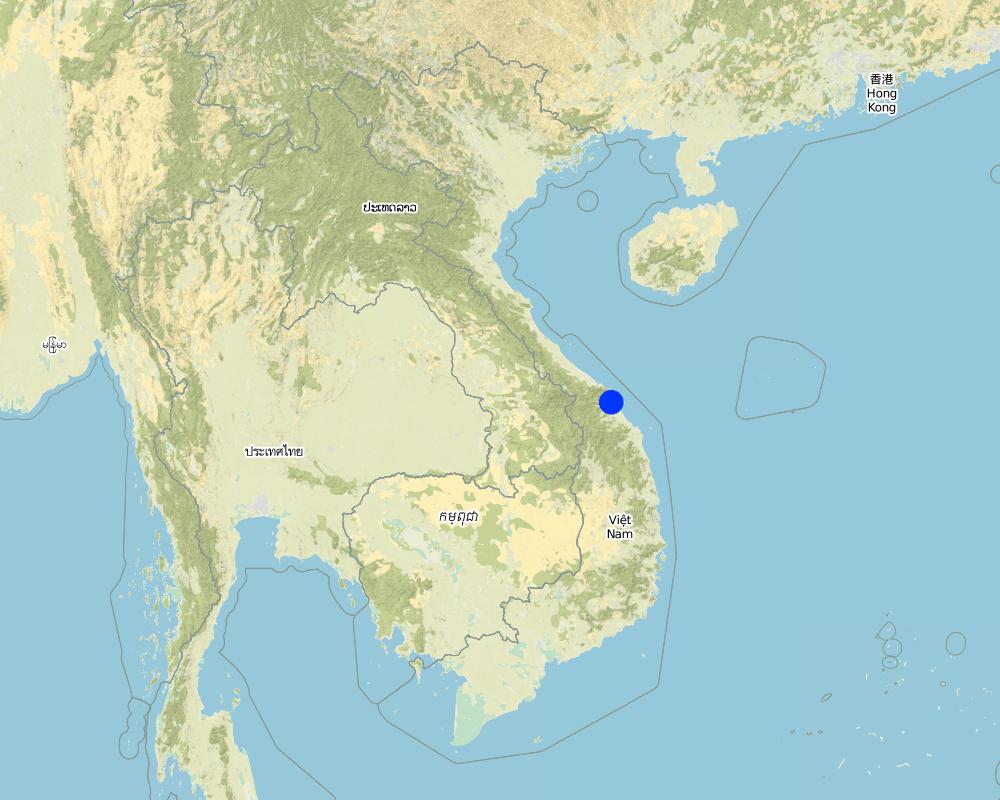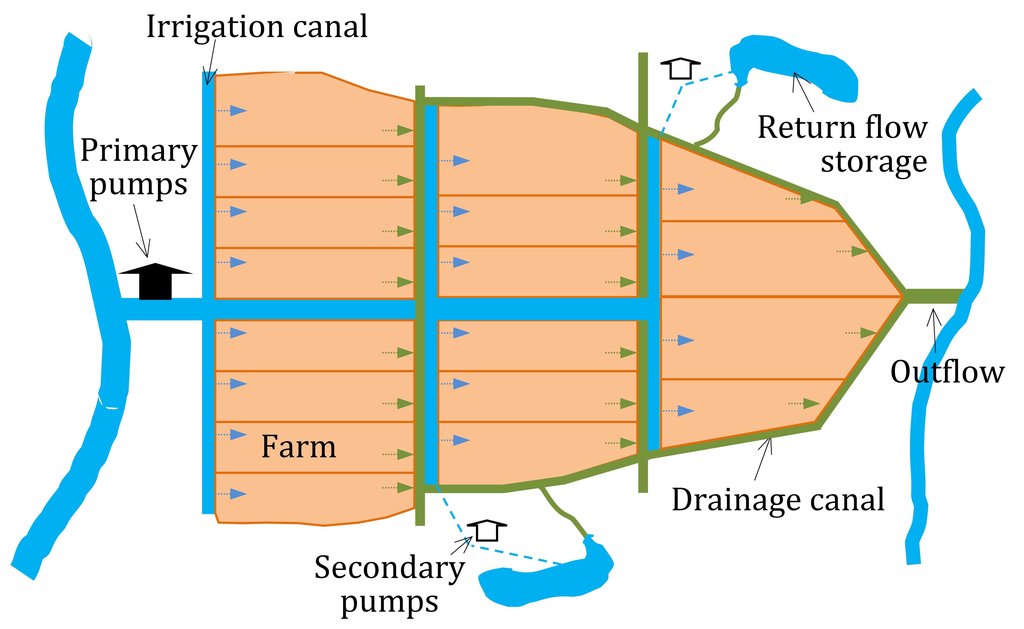Water saving through reuse of return flow in paddy fields [Вьетнам]
- Создание:
- Обновить:
- Составитель: Justyna Sycz
- Редактор: –
- Рецензенты: David Streiff, Deborah Niggli, Alexandra Gavilano
technologies_1277 - Вьетнам
- Полная аннотация в формате PDF
- Полная аннотация в формате PDF для вывода на печать
- Полная аннотация в формате интернет-страницы
- Полная аннотация (неотформатированно)
- Water saving through reuse of return flow in paddy fields: 5 января 2017 г. (inactive)
- Water saving through reuse of return flow in paddy fields: 29 апреля 2017 г. (inactive)
- Water saving through reuse of return flow in paddy fields: 3 мая 2017 г. (inactive)
- Water saving through reuse of return flow in paddy fields: 11 августа 2019 г. (public)
Просмотреть разделы
Развернуть все Свернуть все1. Общая информация
1.2 Контактные данные специалистов и организаций, участвующих в описании и оценке Технологии
Название проекта, содействовавшего документированию/оценке Технологии (если применимо)
Book project: Making sense of research for sustainable land management (GLUES)Название проекта, содействовавшего документированию/оценке Технологии (если применимо)
Land Use and Climate Change Interactions in Central Vietnam (LUCCi / GLUES)Название организации (-ий), содействовавших документированию/оценке Технологии (если применимо)
Technische Hochschule Köln (TH Köln) - Германия1.3 Условия, регламентирующие использование данных, собранных ВОКАТ
Составитель и ответственный(-ые) специалист(-ы) согласны с условиями, регламентирующими использование собранных ВОКАТ данных:
Да
1.4 Декларация по устойчивости описываемой Технологии
Вызывает ли описанная здесь Технология проблемы деградации земель настолько, что ее нельзя назвать природосберегающей?
Нет
1.5 Ссылка на Анкету (ы) по Подходам УЗП (документируется с использованием ВОКАТ)
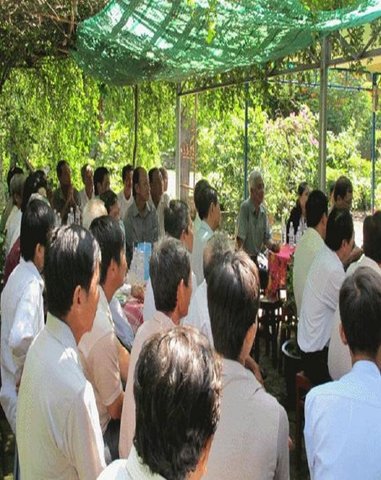
Vu Gia Thu Bon River Basin Information Centre [Вьетнам]
The VGTB River Basin Information Centre (RBIC) offers decision support tools for stakeholders and aims at providing comprehensive information and consulting services to the water and land users according to their demands.
- Составитель: Justyna Sycz
2. Описание Технологии УЗП
2.1 Краткое описание Технологии
Определение Технологии:
Return flow from paddy fields is strategically collected before being lost to rivers and is reused as an effective source of agricultural water.
2.2 Подробное описание Технологии
Описание:
Return flow from paddy fields is defined as applied water that is not lost by evapotranspiration but returns to an aquifer or surface water body (Womach, 2005). The two types of return flow are surface and sub-surface. Surface return flow accounts for the major proportion. If surface return flow is strategically collected before entering rivers, it can be used as an ‘extra’ effective source of agricultural water supply (Phil King, 2008; Simons et al., 2015). Because paddies effectively purify water by absorbing nitrogen and phosphorus, this produces return flow of an acceptable quality for irrigation purposes. Return flow can be collected by drainage canals and stored in ponds and reservoirs, and then returned to pumps for reapplication. This technology offers one solution towards overcoming a deficit of irrigation water.
The goal of this technology is to store and reuse surface return flow from paddy farms to enhance irrigation efficiency. The purpose of constructing temporary barriers in drainage canals is to minimise water wastage and optimise the possibility of collecting and recycling surface return flow. Return flow from irrigation system is stored in surrounding ponds and reservoirs Return flow can only be used when it is captured in a storage structure or drain which has a hydraulic link to the irrigation source: thus an integrated framework for the reuse system consisting of both hydraulic, and management, links should be established. Within the scope of this study, the Water Management Unit (WMU) is understood as an integrated irrigation and drainage system consisting of four components: (i) the hydrological catchment which covers both non-irrigated and irrigated area; (ii) the source scheme generating return flow; (iii) the reuse scheme that is hydraulically connected with the source scheme; and (iv) a drainage system functioning as a harvesting as well as a supply structure.
Before implementing such a system it is recommended to analyse the correlation between irrigation efficiency and reuse of return flow, as well as developing a framework for managing and recycling return flow. Investigation aims at identifying the potential of return flow for irrigation; determining its quantity and quality; and developing an efficient and sustainable reuse framework. Water balance calculations, field measurements, water quality sampling and interviewing are all used for this purpose.
In the study area, long dry seasons cause severe water shortages and problems with saline intrusion. The study area is mainly covered by paddy, vegetables and other annual crops such as maize, sweet potatoes, peanuts and sugarcane. Paddy rice, which consumes a high proportion of the freshwater, is the dominant crop. Agricultural land in the downstream area is irrigated through gravity or pump irrigation systems. Here results indicate that the irrigation efficiency can be improved significantly: the irrigation efficiency of Tu Cau and Thanh Quyt irrigation schemes is projected to increase respectively by 1.8 and 1.4 times.
Reuse of return flow can be applied in all WMUs where the drainage canals are connected with storage tanks. Scientific and technical support tools are offered by the Vu Gia Thu Bon River Basin Information Centre. The centre was established in Danang providing a comprehensive information service to farmers and other water users – it includes capacity building and consulting services also.
2.3 Фотографии, иллюстрирующие Технологию
Комментарии к фотографиям:
Total area covered by the SLM Technology is 0.916 km2. The research area is located in the downstream of the Vu Gia Thu Bon Basin (VGTB), Central Coast of Vietnam. Based on the hydraulic connectivity, the lowland of the VGTB is divided into 13 Water Management Units (WMU) (Viet, 2014). Of which, the Dong Quang and Tu Cau WMUs are selected to conduct the field survey and water quality sampling.
2.5 Страна/ регион/ места, где применяется Технология, информация о которых собрана в данной Анкете
Страна:
Вьетнам
Административная единица (Район/Область):
Quang Nam
Более точная привязка места:
Dien Ban
Map
×2.6 Сколько лет применяется данная Технология
Если год начала применения Технологии достоверно неизвестен, дайте примерную оценку:
- менее 10 лет назад (недавняя)
2.7 Внедрение Технологии
Укажите, как именно Технология УЗП была внедрена:
- как инновация (инициатива) землепользователей
- в качестве научного/ полевого эксперимента
3. Классификация Технологии УЗП
3.1 Основные цели и задачи реализации Технологии
- повышение производства
- сохранение экосистем
3.2 Текущий(-ие) тип(-ы) землепользования на территории, где применяется Технология

Пахотные угодья и плантации
- Однолетние культуры
- Многолетние (недревесные) культуры
- Древесные и кустарниковые культуры
Ежегодный урожай - Уточните культуры:
- зерновые культуры - кукуруза
- зерновые культуры - рис (заболоченные территории)
- корневые / клубнеплодные культуры - сладкий картофель, ямс, таро / кокоям, другие
- vegetables
Многолетние (недревесные) культуры - Уточните культуры:
- сахарный тростник
Древесные и кустарниковые культуры - Уточните культуры:
- орехи (Бразильский орех, фисташки, грецкие орехи, миндаль и т. д.)
Число урожаев за год:
- 2
Поясните:
Longest growing period in days: 130, Longest growing period from month to month: 20th December to 28th April; Second longest growing period in days: 110, Second longest growing period from month to month: 20th May to 06th September
Пояснения:
Major land use problems (compiler’s opinion): The lowland part of Vu Gia Thu Bon is an intensive agricultural area. Rice cultivation, which consumes a high proportion of fresh water, accounts for 70% of total agricultural land (Ribbe et al., 2011). Since 2005, due to the impacts of droughts and saltwater intrusion, water for irrigation during the dry seasons has become an increasing problem in the lowland area of this basin. Simultaneously, the irrigation efficiency of this region is relative low. Various measures are applied to address water scarcity for irrigation. Reusing return flow is regarded as a potentially new measure to reduce the severity of the irrigation deficit in dry periods.
Major land use problems (land users’ perception): Based on the information provided by the Department of Natural Resources and Environment (DONRE) for Quang Nam Province, this basin now faces the problem of temporarily insufficient irrigation water. This situation is caused by droughts, insufficient reservoir capacity, salinity intrusion and ineffective irrigation management.
3.4 Водоснабжение
Обеспеченность водой участков, где реализуется Технология :
- полное орошение
3.5 Категория УЗП, к которой относится Технология
- сбор атмосферных осадков
- управление поверхностными водами (родники, реки, озёра, моря)
3.6 Мероприятия УЗП, выполняемые в рамках Технологии

инженерные мероприятия
- И5: Дамбы, водохранилища, пруды
- И6: Стенки, барьеры, заборы, изгороди

управленческие мероприятия
- У2: Изменение формы/ интенсивности хозяйствования
- У6: Управление отходами (переработка, вторичное использование, снижение количества отходов)
3.7 Основные проблемы деградации земель, на решение которых направлена Технология

деградация водных ресурсов
- Вуп: изменение объема поверхностного стока
Пояснения:
Main causes of degradation: crop management (annual, perennial, tree/shrub) (Paddy rice requires huge amounts of water. Meanwhile, the coefficient of irrigation return flow from paddy field is also quite high.), industrial activities and mining (Hydropower construction reduces water availability for irrigation), over abstraction / excessive withdrawal of water (for irrigation, industry, etc.) (It causes water waste and reduces irrigation efficiency.), change of seasonal rainfall (It affects the paddy water balance and actual irrigation need.), droughts (It causes saltwater intrusion.)
Secondary causes of degradation: change in temperature (It relates to evapotranspiration.), inputs and infrastructure: (roads, markets, distribution of water points, other, …), governance / institutional
3.8 Предотвращение и снижение деградации земель, или восстановление нарушенных земель
Укажите цель Технологии по отношению к деградации земель :
- снижение деградации земель
4. Технические характеристики, мероприятия по практической реализации, вложения и стоимость
4.1 Технический рисунок, иллюстрирующий Технологию
Спецификация (пояснения к техническому рисунку):
Methods of recycling return flow from paddy fields: The surface return flow can be captured by drainage canals and stored in tanks: return water from these reservoirs is pumped back into irrigation canals.
In 2012, the first on-farm irrigation structure was initially implemented in the Tu Cau WMU in order to use return flow for irrigation purposes. The existing Sen Pond was enlarged and a temporary pumping station was installed to pump water into the irrigation canal system.
According to the pumping diary of Tu Cau station (in Winter-Spring crop 2013), there were totally 7 irrigation periods (8-11 days/period). Total input water (including effective rainfall) during the measuring period from 01 March to 10 April was about 28,000 m3. Meanwhile the total volume of return flow of the Tu Cau site was 16,176 m3. This amount of return flow has the potential to irrigate the agricultural area for about 16 days, equivalent to one and a half irrigation periods. The overall efficiency of the irrigation system will be significantly improved.
Location: Lowland area of VGTB Basin. Quang Nam Province
Date: January 2014
Technical knowledge required for field staff / advisors: high
Technical knowledge required for land users: low
Main technical functions: water harvesting / increase water supply
Dam/ pan/ pond
Depth of ditches/pits/dams (m): 2
Width of ditches/pits/dams (m): 194.9
Length of ditches/pits/dams (m): 399.4
Wall/ barrier
Height of bunds/banks/others (m): 0.5
Width of bunds/banks/others (m): 0.25
Length of bunds/banks/others (m): 1.26
Construction material (other): Stone, sandy bags and bamboo sticks
Specification of dams/ pans/ ponds: Capacity 116764.59m3
Catchment area: 77860 m²m2
Beneficial area: 30 ham2
Other type of management: Return flow is the part of drainage flow, it is necessary to enhance the institutional link to develop the reuse framework for the study area. Think about reforming IMC to IDMC with D is drainage.
Автор:
Trinh Quoc Viet
4.2 Общая информация по необходимым вложениям и стоимости
другая/ национальная валюта (название):
VND
Если это необходимо, укажите обменный курс от доллара США к местной валюте (например, 1 доллар США = 79,9 бразильского реала): 1 доллар США =:
20828,0
4.3 Мероприятия, необходимые для начала реализации
| Деятельность | Время (сессия) | |
|---|---|---|
| 1. | Building temporary barrier in drainage canal | |
| 2. | Dredging and expanding Sen Pond | 12 months |
| 3. | Installing and operating the temporary pump at Sen Pond, P is 15KW (Q=520-600m3/h) |
4.4 Вложения и затраты, необходимые для начала реализации
| Опишите затраты | Единица | Количество | Затраты на единицу | Общая стоимость на единицу | % затрат, оплаченных землепользователями | |
|---|---|---|---|---|---|---|
| Оплата труда | labour | 1,0 | 3046,52 | 3046,52 | ||
| Оборудование | machine use | 1,0 | 5344,09 | 5344,09 | ||
| Оборудование | hammer, iron wire | 1,0 | 2,4 | 2,4 | 100,0 | |
| Строительные материалы | Stone,sandy bags,bamboo sticks | 1,0 | 6,45 | 6,45 | 100,0 | |
| Строительные материалы | Earth, concrete | 1,0 | 1335,8 | 1335,8 | ||
| Общая стоимость запуска Технологии | 9735,26 | |||||
| Общие затраты на создание Технологии в долларах США | 0,47 | |||||
Пояснения:
Duration of establishment phase: 12 month(s)
4.5 Поддержание/ текущее обслуживание
| Деятельность | Сроки/ повторяемость проведения | |
|---|---|---|
| 1. | Temporary barrier | each cropping season |
| 2. | Temporary pump | annually |
4.6 Стоимость поддержания/ текущего обслуживания ( в год)
| Опишите затраты | Единица | Количество | Затраты на единицу | Общая стоимость на единицу | % затрат, оплаченных землепользователями | |
|---|---|---|---|---|---|---|
| Оплата труда | labour | 1,0 | 24,0 | 24,0 | 30,0 | |
| Оборудование | machine use | 1,0 | 38,41 | 38,41 | ||
| Строительные материалы | Stone,sandy bags,bamboo sticks | 1,0 | 3,22 | 3,22 | 100,0 | |
| Общая стоимость поддержания Технологии | 65,63 | |||||
4.7 Наиболее значимые факторы, влияющие на стоимость затрат
Опишите наиболее значимые факторы, влияющие на стоимость затрат:
Prices of the material and equipment; the approval procedure and disbursement process of the project of “Dredging and expanding Sen Pond”; the compensation cost for the farmers; the cost of operating and maintaining temporary pump; the cost of reinforcing the drainage canals.
5. Природные и социально-экономические условия
5.1 Климат
Среднегодовое количество осадков
- < 250 мм
- 251-500 мм
- 501-750 мм
- 751-1000 мм
- 1001-1500 мм
- 1501-2000 мм
- 2001-3000 мм
- 3001-4000 мм
- > 4000 мм
Пояснения/ комментарии по осадкам:
Average annual rainfall in period 1978-2010 of research area is 2105mm. February to April is driest period as rainfall in this period accounts only 3-5% of annual rainfall.
Агроклиматическая зона
- Умеренно-влажная
Thermal climate class: tropics. humid tropical monsoon climate
5.2 Рельеф
Склоны (преобладающие):
- пологие (0-2%)
- покатые (3-5%)
- покато-крутые (6-10%)
- крутые (11-15%)
- очень крутые (16-30%)
- чрезвычайно крутые (31-60%)
- обрывистые (>60%)
Формы рельефа:
- плато/ равнины
- гребни хребтов/холмов
- склоны гор
- склоны холмов
- подножья
- днища долин
Зона высотной поясности:
- 0-100 м над уровнем моря
- 101-500 м н.у.м.
- 501-1000 м н.у.м.
- 1001-1500 м н.у.м.
- 1501-2000 м н.у.м.
- 2001-2500 м н.у.м.
- 2501-3000 м н.у.м.
- 3001-4000 м н.у.м.
- > 4 тыс. м н.у.м.
5.3 Почвы
Средняя мощность почв:
- поверхностные (0-20 см)
- неглубокие (21-50 см)
- умеренно глубокие (51-80 см)
- глубокие (81-120 см)
- очень глубокие (> 120 см)
Гранулометрический состав (верхнего горизонта):
- грубый крупнозернистый/ лёгкий (песчаный)
- средние фракции (суглинистый, супесчаный)
Содержание органического вещества в верхнем горизонте:
- среднее (1-3%)
5.4 Доступность и качество воды
Уровень грунтовых вод:
< 5 м
Доступность поверхностных вод:
средняя
Качество воды (без обработки):
исключительно для сельскохозяйственного использования (орошение)
5.5 Биоразнообразие
Видовое разнообразие:
- низкое
5.6 Характеристика землепользователей, применяющих Технологию
Рыночная ориентация производства:
- натуральное хозяйство (самообеспечение)
- смешанный (натуральный / коммерческий)
Доходы из других источников:
- > 50% всех доходов
Относительный уровень достатка:
- плохой
- средний
Индивидуальное или коллективное хозяйство:
- частное/ домовладение
Уровень механизации:
- ручной труд
- механизировано/ есть автотранспорт
Пол:
- женщины
- мужчины
Укажите другие важные характеристики землепользователей:
Land users applying the Technology are mainly common / average land users
Population density: > 500 persons/km2
Annual population growth: 1% - 2%
1% of the land users are very rich and own 3% of the land.
2% of the land users are rich and own 7% of the land.
70% of the land users are average wealthy and own 60% of the land.
25% of the land users are poor and own 20% of the land.
2% of the land users are poor and own 10% of the land.
Off-farm income specification: There is a large industrial park located near the study site and a large part of the working population in the region is earning income by working in the factories.
5.7 Средняя площадь земель, используемых землепользователями с применением Технологии
- < 0,5 га
- 0,5-1 га
- 1-2 га
- 2-5 га
- 5-15 га
- 15-50 га
- 50-100 га
- 100-500 га
- 500-1000 га
- 1000-10000 га
- > 10000 га
Считается ли это мелким, средним или крупным хозяйством (по местным масштабам)?
- мелкое
5.8 Собственность на землю, права на земле- и водопользование
Землевладелец:
- государственная
- farmer, individual
Право водопользования:
- неограниченное (неконтролируемое)
- farmer, individual
5.9 Доступ к базовым услугам и инфраструктуре
медицинское обслуживание:
- плохой
- средний
- хорошая
образование:
- плохой
- средний
- хорошая
технические консультации:
- плохой
- средний
- хорошая
занятость (вне хозяйства):
- плохой
- средний
- хорошая
рынки:
- плохой
- средний
- хорошая
электроснабжение:
- плохой
- средний
- хорошая
транспорт и дорожная сеть:
- плохой
- средний
- хорошая
водоснабжение и канализация:
- плохой
- средний
- хорошая
финансовые услуги:
- плохой
- средний
- хорошая
6. Воздействия и заключительные положения
6.1 Влияние Технологии УЗП в пределах территории ее применения
Социально-экономическое воздействие
Продуктивность
производство сельскозяйственных культур
Комментарий/ пояснения:
A small farming area within an irrigation scheme will be used to store drained water.
Доступность и качество воды
доступность оросительных вод
Комментарий/ пояснения:
The technology helps to minimise negative impacts of saltwater intrusion on irrigation
потребность в оросительной воде
Комментарий/ пояснения:
The technology helps to reduce water abstracted from river in dry periods when saltwater intrusion occurring
Другое социально-экономическое воздействие
Increased irrigation efficiency
Количество до применения УЗП :
37%
Количество после применения УЗП:
68%
Комментарий/ пояснения:
The irrigation efficiency is improved significantly (increasing about 1.8 times) in the case of recycling return flow
Социальное и культурное воздействие
смягчение конфликтов
contribution to human well-being
Комментарий/ пояснения:
This technology helps to minimise the damage to agricultural production caused by excess salt during the dry periods. It brings the benefits for the farmers by increasing the crop yields and helps to improve their livelihoods.
Экологическое воздействие
Водный цикл/ поверхностный сток
количество воды
Комментарий/ пояснения:
Less freshwater is used for irrigation purposes
поверхностный сток
уровень грунтовых/ подземных вод
Почвы
влажность почв
засоленность
Комментарий/ пояснения:
50/270 ha of the Tu Cau Irrigation scheme is additionally supplied water in the dry periods as rivers are affected by saltwater intrusion
Другие экологические последствия
Loss of land for enlarging the Send Pond
contamination of reused water by agro-chemicals
6.3 Подверженность и чувствительность Технологии УЗП к постепенным изменениям климата и экстремальным погодным явлениям/ стихийным бедствиям, связанным с изменением климата (в понимании землепользователей)
Постепенное изменение климата
Постепенное изменение климата
| Сезон | увеличение или уменьшение | Насколько успешно Технология справляется с этим? | |
|---|---|---|---|
| среднегодовые температуры | увеличилось | плохо |
Экстремальные явления, связанные с изменением климата (стихийные бедствия)
Погодные стихийные бедствия
| Насколько успешно Технология справляется с этим? | |
|---|---|
| местные ливневые дожди | хорошо |
| местные ураганы | не известно |
Стихийные бедствия климатического характера
| Насколько успешно Технология справляется с этим? | |
|---|---|
| засухи | хорошо |
Гидрологические стихийные бедствия
| Насколько успешно Технология справляется с этим? | |
|---|---|
| регулярные наводнения (выход рек из берегов) | не известно |
Другие воздействия, связанные с изменением климата
Другие воздействия, связанные с изменением климата
| Насколько успешно Технология справляется с этим? | |
|---|---|
| сокращение вегетационного периода | плохо |
6.4 Анализ эффективности затрат
Насколько получаемый результат сопоставим с первоначальными вложениями (с точки зрения землепользователей)?
Эффективность затрат в краткосрочной перспективе:
слабо отрицательное
Эффективность затрат в долгосрочной перспективе:
очень позитивное
Насколько получаемый результат сопоставим с текущими расходами по поддержанию технологии (с точки зрения землепользователей)?
Эффективность затрат в краткосрочной перспективе:
очень позитивное
Эффективность затрат в долгосрочной перспективе:
очень позитивное
6.5 Внедрение Технологии
Среди применяющих Технологию землепользователей, какова доля лиц, применяющих её по собственной инициативе, т.е. без какого-либо материального стимулирования со стороны?
- 51-90%
Пояснения:
By applying the technology, the potential reuse area of return flow is estimated about 33% of the study area (30.4ha of agricultural area is potentially irrigated by return flow). However, estimating the number of land user families that have implemented the technology is not the initial aim of the study. Therefore, it requires further detailed investigation and social survey as well.
6.7 Сильные стороны/ преимущества/ возможности Технологии
| Сильные стороны/ преимущества/ возможности по мнению землепользователей |
|---|
| Increases the water depth in paddy fields which helps to improve paddy productivity |
| Beneficial/ endangered species might obtain new habitats in the retention area |
| Сильные стороны/ преимущества/ возможности по мнению составителя или других ключевых специалистов |
|---|
| Using return flow is helpful to improve irrigation efficiency. The amount of extracting water for irrigation and the cost of operating an irrigation system can be reduced. |
| The measure contributes to mitigating negative impacts of drought and salt intrusion. During the dry season the river water becomes more and more saline due to salt water intrusion. Salinity also builds up from not leaching out salts in the subsoil |
| Take advantages of available drainage canals, ponds, reservoirs to reduce the investment costs |
| Acceptable water quality because of the purification function of paddies which removes nutrients from the water |
| Low costs of conveyance systems because of short distance. More flexibility of allocation because of stable return flow. Less conflict between sectors. |
6.8 Слабые стороны/ недостатки/ риски Технологии и пути их преодоления
| Слабые стороны/ недостатки/ риски по мнению составителя или ответственных специалистов | Возможные пути их преодоления/снижения? |
|---|---|
| Temporal and spatial variation causes difficulty in using return flow. The differences in soil type, terrain, storage capacity of the paddy fields and irrigation method (e.g. irrigation techniques, the amount of input water and pumping intervals) are major factors influencing the quantity of return flow | Constructing temporary barriers in the drainage canal helps to minimise the water wastage and optimise the possibility of collecting and recycling surface return flow. |
| Using return flow might spread diseases, and weed seeds from affected farms to safe farms | Encourage farmers to comply with the principles of prevention and control diseases in agricultural production. It is necessary to implement preliminary tests and analyses the quality of return water before recycling for irrigation purposes. |
7. Справочные материалы и ссылки
7.1 Методы сбора/ источники информации
- выезды на места, полевые обследования
- опросы землепользователей
Когда были собраны данные (на местах)?
03/08/2015
7.2 Ссылки на опубликованные материалы
Название, автор, год публикации, ISBN:
Kim, H. K. et al. (2009) Estimation of irrigation return flow from paddy fields considering the soil moisture
Где опубликовано? Стоимость?
Agricultural Water Management, 96(5), 875–882.
Название, автор, год публикации, ISBN:
Phil King (2008) Return Flow Efficiency
Где опубликовано? Стоимость?
New Mexico Water Resources Research Institute
Название, автор, год публикации, ISBN:
Simons, G.W.H. et al. (2015) Water reuse in river basins with multiple users: A literature review
Где опубликовано? Стоимость?
Journal of Hydrology. 558–571
Название, автор, год публикации, ISBN:
Ribbe et al. (2011) Annex 2 to Milestone Report 2011 - Description of the Study Region including an updated stakeholder analysis,
Где опубликовано? Стоимость?
LUCCi project. ITT, Cologne University of Applied Sciences
Ссылки и модули
Развернуть все Свернуть всеСсылки

Vu Gia Thu Bon River Basin Information Centre [Вьетнам]
The VGTB River Basin Information Centre (RBIC) offers decision support tools for stakeholders and aims at providing comprehensive information and consulting services to the water and land users according to their demands.
- Составитель: Justyna Sycz
Модули
Нет модулей


